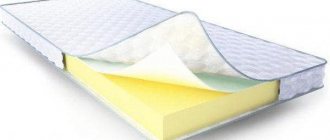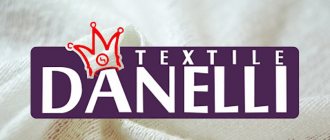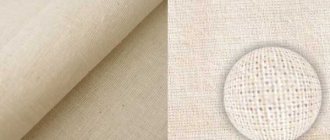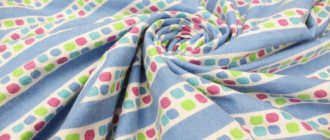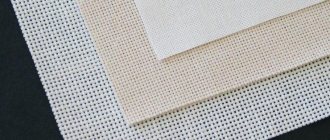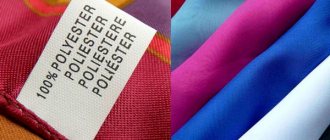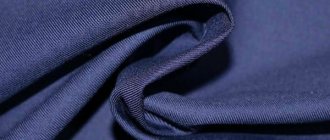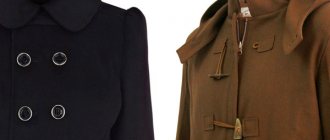Dublerin, what is it and how to use the properties of dublerin in sewing? Dublerin is classified as an adhesive lining material. The very name of the fabric - “dublerin” - indicates that the material is used to duplicate and strengthen certain parts of clothing and more. The use of dublerin gives volume and shape to clothes. Products reinforced with dublerin become more durable, wrinkle less and are not deformed. You can use dublerin with almost all fabrics.
Where is dublerin most often used? Of course, in those places of clothing that are subject to the greatest load, to increase the wear resistance and rigidity of clothing parts.
Dublerin is used to give shape to clothing parts, for example, to give a certain shape to collars. To do this, the neck is treated with a duplicate facing. Dublerin is widely used in children's clothing due to the fact that it is an environmentally friendly material. Most often, the standard colors of the material are found - white, gray, black, however, even such a small variety is enough for its widespread use.
Types of dublerin
Dublerin, what is it and what is it used for?
Dublerin cushioning material can be of several types depending on the scope of its application - with double-sided sizing or without it at all, etc. Sizing is a thin layer of glue applied to the material and dried in a special way. By exposing the adhesive layer to water or high temperatures, it becomes liquid and securely adheres the cushioning material to the product.
The strength of the duplicated fabric depends on its composition, the amount of glue, etc.
There are 3 types of dublerin:
- Fabric – a material made from compacted fabric. Compacted fabric coupled with an adhesive base makes this type of dublerin the most reliable. Fabric dublerin is used for sewing hats, shoes, bags, fur or leather products.
- Knitted pile is a less rigid, but rather dense lining material used for sewing outerwear. Pile dublerin is also used for sewing soft toys. This type of dublerin stretches well, but only in one direction, which is worth considering when sewing clothes.
- Elastic dublerin (knitted) is a pliable material that easily stretches in any direction. Used for sewing skirts, dresses, blouses, shirts, trousers, etc. Retains its shape perfectly even with frequent wear and numerous washes.
What are adhesive edges?
Adhesive edges are made from thread-stitched interlining of different widths. Usually from 1 to 3 cm.
Edges cut into lobes are called lobes. And those cut at an angle of 45 degrees to the direction of the grain thread are oblique.
Mostly, selvedges are used when sewing outerwear to strengthen and prevent stretching of sections, such as sections of armholes, necklines, hem edges, and lapel bends. If you were unable to buy ready-made edges, you can cut them yourself from thread-stitched non-woven fabric to the desired width and direction.
You can get even more information in our online sewing courses.
How to glue dublerin
How to use adhesive doublerin when sewing clothes correctly?
Choose exactly the type of dublerin that suits your product:
- Before using dublerin, determine the adhesive side. To do this, touch the fabric on each side; the rough side will be the adhesive side. It is this that needs to be applied to the wrong side of the main fabric.
- Turn on the iron to the “wool” or “synthetic” mode without steam.
- Next, place the dublerin on the product with the adhesive side down, spray the fabric with water using a spray bottle.
- Using a heated iron, iron the fabric on top with a little force. It is important to press the iron against the fabric for a few seconds, and not to move it over the surface of the dublerin.
- Leave the glued lining material to cool and fix the glue.
How to use doublerin adhesive? Try gluing dublerin onto unnecessary scraps of fabric first to determine the most optimal iron temperature.
How to work with it?
How to glue dublerin onto fabric and avoid mistakes? It is important to choose the type of material that suits your product. Professional craftsmen recommend decatifying the dublerin before use. This is done simply: the cushioning material is placed in warm water for a couple of hours, and then removed and dried. There is no need to squeeze it out. This is done in order to avoid possible shrinkage of the interlining fabric after the first wash. Natural threads are used in production, and therefore this is quite possible.
After drying, the dublerin is ready for use:
- cut out a piece of suitable shape from the cushioning fabric;
- lay out the product you will be working with on a flat surface;
- place a piece of dublerin on top of the product with the adhesive side down;
- Place the auxiliary fabric or gauze on top that you use when ironing;
- apply a hot iron to the surface, use steam for better heating;
- the iron must be applied evenly, with tangential movements, but not moved from side to side;
- Allow the fabric to cool completely before handling.
Benefits of doublerin
The main advantages of dublerin are that it practically does not tear, drapes well, and almost does not peel off.
An important advantage of this cushioning material is the variety of dublerin in terms of density, types of adhesive application, area of application, etc. Dublerin belongs to a whole group of fabrics, which includes various cobwebs, mesh, fleece - thin cushioning materials with glue applied to both sides.
Spandbond, another version of dubbing, is a non-adhesive non-woven material, which, due to its strength and density, is used for duplicating bags, backpacks, and for the production of covering material.
There are also water-soluble and heat-soluble types of dublerin, which are used for embroidery and fixing light fabrics when sewing. After completion of the work, such fabric is removed by rinsing in water or using a heated iron.
Why is it needed?
Let's figure out what it is. Nonwoven or doublerin is a lightweight, thin non-woven material that is used to secure clothing parts over their entire surface. The presence of an adhesive gasket on the parts of the item prevents possible deformation, especially if it has a complex cut, as well as the ability to wash the item without worrying about the safety of its shape and appearance.
On one side of the canvas the material is matte, on the other it is shiny. Make no mistake when gluing: the adhesive side is the one that shines. If the shine of the glue is difficult to visually determine, feel it with your hand. The glue is applied in the form of tangible dots, stripes or cells.
What items definitely require backing with an adhesive backing? These are clothing details such as belts, pockets, collars, straps, shoulder straps, belt loops, straps, flaps, codpieces. In addition, it is imperative to fix the seams when sewing fasteners, necklines, and yokes on skirts. If you are sewing from loose fabrics, be sure to secure details such as buttonholes. Formband can also be used here.
There is another type of material - this is water-soluble interlining for embroidery; unlike the usual one, it is used using a different technology.
Disadvantages of doublerin
Before you start sewing, select the type of dublerin that is suitable for the future product. When using knitted dublerin, pay attention to the direction of stretching of the fabric so that it coincides with the direction of the threads of the main fabric.
If the basic principles of using dublerin are followed, then this material is unlikely to have any shortcomings.
However, here it is worth considering the fact that natural threads are used for the production of dublerin, and not chemical compounds, which indicates the quality and reliability of this material.
How to choose and cut interlining and dublerin?
We choose based on our goals. Typically, the thinner the fabric, the thinner the CPM and vice versa. It happens that it is necessary to give greater rigidity to parts made of thin fabric, then we give preference to a more rigid and dense KPM. If you are in doubt about what density to use, glue 2-3 samples of fabric of different densities with non-woven fabric or dublerin and with your eyes closed (yes, this is not a joke), choose the one you like best by touch. For heavy, dense (coat, suit) fabrics, cushioning materials with a higher density are optimal. For thin (light chiffon and silk) - all kinds of non-woven variations. Tensile and elastic fabrics are duplicated only with knitted pads.
Dublerin on a woven base, there is an edge and it is easy to determine the direction of the grain thread. The direction of the shared thread coincides with the direction on the duplicated part. Non-woven fabric also has a semblance of a grain thread. In the direction where it is more difficult to break and there is a semblance of a shared thread. Accordingly, we combine this direction with the shared thread on the part.
Dublerin analogues
Another name for dublerin is thermal fabric, as it is used as a lining for the main product.
Depending on the purpose of use and the required density, thinner or denser fabric is used for the production of dublerin. During the sewing process, the dublerin is laid out along the grain thread, without cutting out gaps for seams, which can create additional volume.
In addition to dublerin, other lining materials are used when sewing, which are similar in properties to it.
Adhesive beading
This cushioning material is used to strengthen the fronts and sides of men's jackets and other clothing. It has two types - with an adhesive base and without an adhesive coating. Beading is much denser than dublerin and is used in rare individual cases.
Non-woven cushioning materials
Non-woven cushioning materials include non-woven and spunbond. These materials are based on cellulose fibers with the addition of polyester fibers.
Non-woven fabric , similar to dublerin, comes in different densities and thicknesses, from the thinnest and most weightless to dense fabric similar to thin cardboard.
The advantage of non-woven fabric is the ease of cutting the material. Non-woven fabric does not have a longitudinal or transverse thread, so when using it there is no need to waste time on such details.
However, non-woven fabric, along with dublerin, is widely used in tailoring due to its low cost.
Adhesive grosgrain tapes
Used when sewing belts for trousers and skirts. They come in different densities and widths and are selected individually for the product.
Glue webs, mesh, fleece
Glue webs and meshes are used to glue layers of the product. This cushioning material has no backing and is entirely woven from adhesive threads.
Gossamer is a thin and light material that is used in conjunction with thin cotton, chiffon or gauze.
The adhesive mesh is tougher than gossamer and is used with denser fabrics. Adhesive nets are sold with a paper backing that must be removed before use.
Flizofix is a double-sided adhesive sheet. Also sold as nets attached to paper or without it.
What kind of fabric
To understand what it is and how dublerin differs, for example, from non-woven fabric, it is necessary to imagine modern linings on outerwear or evening wear. As a rule, it is a woven or knitted material used primarily to impart a certain rigidity to items and maintain the original shape of parts such as collars, trims or cuffs. In addition, it is widely used in sewing a variety of home textiles, travel or sports equipment, and handicrafts.
A little historical background
Dublerin is a relatively new lining material that is often confused with non-woven fabric. In fact, there is a difference, and it is significant. The material described is woven, i.e. made by interlacing threads. Although there are also knitted options, they are still made from threads, which is very important.
Non-woven fabric is a non-woven fabric with properties reminiscent of rigid paper, made from cellulose. It is impossible to answer the question of which is better: depending on what the matter is needed for, the most optimal option is selected.
The name of the dublerin speaks for itself: it acts as a backup layer, which toughens the main one and helps to maintain the correct shape of the clothing parts longer.
Description
To understand what this fabric looks like, imagine the reverse side of modern coats, light jackets, as well as clothing parts: collars, for example. The dublerin is quite elastic, stretches well, and lays in beautiful, even folds. That is why it is often used not only for its intended purpose, but also in needlework: scrapbooking, sewing children's soft toys, applique, patchwork. Initially, only three possible colors of dublerin were common, which still remain classic: gray, white or black. Today, manufacturers offer a variety of designs.
And now we will move from the description of the material to its composition.
Caring for products with dublerin
Washing clothes and other products with dublerin is carried out on the basis of recommendations for caring for the main fabric of the product. If dublerin or other cushioning material is glued correctly, it will easily withstand washing at high temperatures.
When spinning, select the “delicate fabrics” mode. If the dublerin has become unstuck from the main product, it is necessary to carefully iron it, first straightening it so that under the influence of high temperature the interlining fabric will re-glue smoothly and without wrinkles.
If dublerin was used for sewing lambrequins and other delicate items, it is not recommended to wash them. It is enough to vacuum the lambrequin or clean it with a dry brush.
What varieties are there?
Strength and stretchability are determined by weaving technology:
- Knitted dublerin - made from viscose or polyester fibers by weaving loops. This fabric is more voluminous and elastic in the transverse direction.
- Fabric dublerin usually has a plain weave, it is durable and sometimes very stiff.
Note! How to knit braids - options for knitting simple and complex patterns. Step-by-step description and tips for beginners (90 photos)
There are duplerins for narrow purposes - corset, chiffon, collar, elastic.
Where to buy dublerin
Buying dublerin for needlewomen will not cause any difficulties, since due to its popularity and widespread use, this cushioning material is sold in almost every fabric store.
The cost of dublerin is on average 100-150 rubles per meter. The price may vary depending on the density of the fabric, the presence of an adhesive base, color and other parameters.
You can also buy dublerin in online stores, where they offer a large selection of lining material of various shapes (ribbons, canvas, etc.) and cost. Buying dublerin online is a great option for bulk orders.
Dublerin is an indispensable material for sewing clothes and handicrafts. The high cost of the fabric is justified by the many advantages of dublerin, from ease of use to the ability to perfectly hold the shape of the product.
Useful tips
Proper care of things with cushioning fabric will allow you to maintain their shape and attractive appearance for a long time:
- wash in accordance with the instructions on the label for caring for the main material of the product;
- It is recommended to spin at the end of washing, setting the mode “for delicate fabrics”;
- the peeled-off dublerin can be glued again, but before doing this, carefully and very carefully straighten it, otherwise the interlining fabric will not adhere unevenly;
- so that the interlining does not stand out from the main fabric, cut its bottom with a zigzag, then a distinct border will not be obvious;
- Lambrequins on dublerin are prohibited from being washed; dry cleaning with a vacuum cleaner or brush is recommended.
You can buy dublerin at any fabric or handicraft store, paying 100-250 rubles per meter. The price may increase or decrease depending on the density of the interlining fabric, color, and type of adhesive layer. The rather high cost is justified by the advantages of dublerin:
- ease of use;
- the ability to retain its properties after numerous washes and intensive wearing of clothes;
- a wide range of interlining fabric is presented in options with different densities, colors and adhesive base, which allows you to match it to any fabric;
- indispensable when sewing knitwear and fur products.
The beauty of clothing is in the details. To get a high-quality product with an excellent appearance, a combination of good fabric and a successful design is not enough - the item must keep its shape, not move apart or sag. Dublerin will help ensure the strengthening of individual elements and the necessary rigidity.
